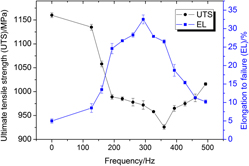Crossref Citations
This article has been cited by the following publications. This list is generated based on data provided by
Crossref.
Ye, Xiaoxin
Tse, Zion T.H.
Tang, Guoyi
and
Song, Guolin
2014.
RETRACTED: Effect of electroplastic rolling on deformability, mechanical property and microstructure evolution of Ti–6Al–4V alloy strip.
Materials Characterization,
Vol. 98,
Issue. ,
p.
147.
Ye, Xiaoxin
Liu, Tao
Ye, Yongda
Wang, Haibo
Tang, Guoyi
and
Song, Guolin
2015.
RETRACTED: Enhanced grain refinement and microhardness of Ti–Al–V alloy by electropulsing ultrasonic shock.
Journal of Alloys and Compounds,
Vol. 621,
Issue. ,
p.
66.
Ye, Xiaoxin
Tse, Zion T.H.
and
Tang, Guoyi
2015.
Mechanical properties and tensile fracture of Ti–Al–V alloy strip under electropulsing-induced phase change.
Journal of Materials Research,
Vol. 30,
Issue. 2,
p.
206.
Ye, Xiaoxin
Tse, Zion T.H.
Tang, Guoyi
and
Song, Guolin
2015.
RETRACTED: Mechanical properties and phase transition of biomedical titanium alloy strips with initial quasi-single phase state under high-energy electropulses.
Journal of the Mechanical Behavior of Biomedical Materials,
Vol. 42,
Issue. ,
p.
100.
Gui, Fang
Zhou, Shi Yun
Yan, Wan Jun
Zhang, Chun Hong
and
Chen, Shao Bo
2015.
First-Principles Study of Electronic Structure and Optical Properties of V-Doped CrSi<sub>2</sub>.
Advanced Materials Research,
Vol. 1104,
Issue. ,
p.
125.
Shi, Wei Mei
Ding, Ye Chun
and
Wu, Long Huo
2015.
The Adsorption Properties of Ciprofloxacin by KMnO<sub>4 </sub>Modified <i>Durio zibethinus </i>Murr Shells.
Advanced Materials Research,
Vol. 1104,
Issue. ,
p.
111.
Ye, Xiaoxin
Tse, Zion T.H.
Tang, Guoyi
Li, Xiaohui
and
Song, Guolin
2015.
RETRACTED: Effect of electropulsing treatment on microstructure and mechanical properties of cold-rolled pure titanium strips.
Journal of Materials Processing Technology,
Vol. 222,
Issue. ,
p.
27.
Liu, Qi Song
Xu, Bo
He, Jin Long
Sun, Ru
and
Chang, Hong Gang
2015.
Optimal Conditions for Bio-Oxidation of Biodesulfurization in Natural Gas Sweetening Process Using <i>Thiobacillus</i>.
Advanced Materials Research,
Vol. 1104,
Issue. ,
p.
57.
Ye, Xiaoxin
Tang, Guoyi
and
Song, Guolin
2015.
RETRACTED: The effect of electropulsing induced gradient topographic oxide coating of Ti–Al–V alloy strips on the fibroblast adhesion and growth.
Surface and Coatings Technology,
Vol. 261,
Issue. ,
p.
213.
Xin, Ying
Jiang, Wei Hui
Feng, Guo
Liu, Jian Min
Zhang, Quan
Wu, Qian
and
Miao, Li Feng
2015.
Low Temperature Synthesis of Yttrium-Stabilized Zirconia (YSZ) Fibers by Non-Hydrolytic Sol-Gel Method.
Advanced Materials Research,
Vol. 1104,
Issue. ,
p.
101.
Ye, Xiaoxin
Tse, Zion T. H.
Tang, Guoyi
and
Song, Guolin
2015.
Retracted: Effect of High‐Energy Electropulsing on the Phase Transition and Mechanical Properties of Two‐Phase Titanium Alloy Strips.
Advanced Engineering Materials,
Vol. 17,
Issue. 7,
p.
995.
Ye, Xiaoxin
Wang, Lingsheng
Tse, Zion T.H.
Tang, Guoyi
and
Song, Guolin
2015.
RETRACTED: Effects of high-energy electro-pulsing treatment on microstructure, mechanical properties and corrosion behavior of Ti–6Al–4V alloy.
Materials Science and Engineering: C,
Vol. 49,
Issue. ,
p.
851.
Ye, Xiaoxin
Tse, Zion T.H.
Tang, Guoyi
Geng, Yubo
and
Song, Guolin
2015.
RETRACTED: Influence of electropulsing globularization on the microstructure and mechanical properties of Ti–6Al–4V alloy strip with lamellar microstructure.
Materials Science and Engineering: A,
Vol. 622,
Issue. ,
p.
1.
Zhou, Tong Qing
Chen, Ting
Jiang, Wei Hui
Liu, Jian Min
Zhang, Xiao Jun
and
Miao, Li Feng
2015.
Preparation of α-Al<sub>2</sub>O<sub>3</sub> Powders via Non-Hydrolytic Sol-Gel Method.
Advanced Materials Research,
Vol. 1104,
Issue. ,
p.
3.
Ni, Hao Yin
and
Chen, Cai Xia
2015.
Computational Results Show Gas Phase Reactions Have Great Impact on the Deposition Rate of Silicon in Siemens CVD Reactors.
Advanced Materials Research,
Vol. 1104,
Issue. ,
p.
39.
Jiang, Shi Feng
Li, Zhen Qiu
Chen, Hong Nan
and
Wang, Er Qiang
2015.
Cs-P Oxide Catalysts for Aldol Condensation to Produce Methyl Acrylate.
Advanced Materials Research,
Vol. 1104,
Issue. ,
p.
51.
Gao, Xiao Ju
Yan, Dong Ming
Cao, Jian Wu
Zhang, Cong
Mu, Xiao Ming
Zhou, Ya Wei
Wang, Meng
Qu, Fa Zeng
Li, Guo Bin
Wang, Guo Jiang
and
Zhang, Da Jiang
2015.
The Study on the Property and the Microstructure of Pressureless Sintered h-BN Ceramics.
Advanced Materials Research,
Vol. 1104,
Issue. ,
p.
9.
Ye, Yongda
Kuang, Jie
Kure-Chu, Song-Zhu
Song, Guolin
Sun, Zhiyan
and
Tang, Guoyi
2016.
Improvement of microstructure and surface behaviors of welded S50C steel components under electropulsing assisted ultrasonic surface modification.
Journal of Materials Research,
Vol. 31,
Issue. 14,
p.
2125.
Jiang, Tianhao
Peng, Linfa
Yi, Peiyun
and
Lai, Xinmin
2016.
Flow behavior and plasticity of Ti–6Al–4V under different electrically assisted treatments.
Materials Research Express,
Vol. 3,
Issue. 12,
p.
126505.
Kuang, Jie
Low, Thaddeus Song En
Niezgoda, Stephen R.
Li, Xiaohui
Geng, Yubo
Luo, Alan A.
and
Tang, Guoyi
2016.
Abnormal texture development in magnesium alloy Mg–3Al–1Zn during large strain electroplastic rolling: Effect of pulsed electric current.
International Journal of Plasticity,
Vol. 87,
Issue. ,
p.
86.
